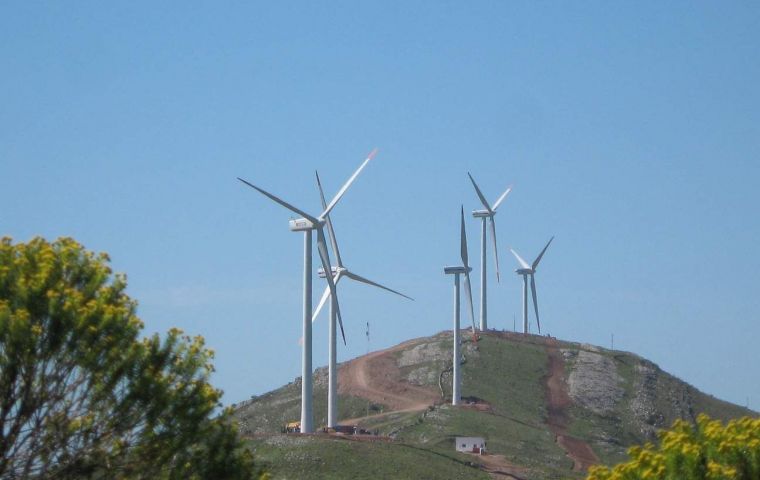MercoPress. South Atlantic News Agency
Growing doubts about Uruguay’s goal of 1.2GW wind power by 2015
 Some wind farms are already successfully in production
Some wind farms are already successfully in production Uruguay’s ambition to have 1.2GW of wind power in operation by 2015 may have to be delayed for several years because logistical problems and tightening returns could make some projects unfeasible.
Even the Energy Director Ramón Méndez, admits that not all projects being contracted today might be built, despite the country’s urgent need for more power.
But “we still have the 500MW goal”, Méndez insisted referring to Uruguay’s original wind target, a big step up from the 43MW in operation now.
Wind suddenly became a hot commodity last year, when the government saw how cheaply it could contract projects. It quickly set its sights sky-high, attempting to contract as much as the grid can handle, at breakneck speed.
But with developers having dropped asking rates by 30 dollars per MWh in some cases, and given the enormous logistical challenges they will face in trying to come on line on time, some projects might never grow to fruition. As one government source admits: “Some of these projects are a little bit bogus.”
Uruguay was mighty pleased to receive asking rates of 63.50/MWh in its August 2011 tender. In the previous tender, signed off in January that year, prices had come in at a low of 81.16/MWh.
There were three main reasons behind the steep drop in price: a bonus of 110/MWh being offered for all energy produced until January 2015; the stiff competition; and the influence of Brazil’s tenders producing low-tariff electricity contracts.
To take advantage of the cheap rates, a tender was announced in November, before being quickly scrapped in favour of a faster method of directly contracting those projects that failed to secure deals in the second tender, providing they were willing to accept a rate of 63.50 dollars per MWh, with a maximum of 50MW.
To the shock of the government and the industry, 13 of the 14 second-round “losers” were willing to make a go of it, including project developers that had previously been asking for upwards of 90/MWh.
For this round, the 110/MWh bonus will run until April 2015. At least nine of those contracts have been given the go-ahead, while the other four are sorting out connection arrangements.
Those directly contracted projects are still waiting for the comptroller and auditor-general’s office to finish analysing the contracts for approval, after which they can be signed. How long that might take is unknown, and the Ministry of Industry and Energy has no power to speed things up.
There is another area, however, where it has made things happen. Almost all of the projects have been waiting on environmental permitting. The Environment Ministry, has been trying to impose stringent guidelines, such as ¬requiring that turbines be kept at least 3km from homes.
Under pressure from Méndez and the industry, Dinama has apparently agreed to soften these demands, at least for the ten or so projects under review. Future projects may yet face strict regulations.
Logistical complications also loom, including limited port access in the face of high demand.
Taken together, the delays will make it difficult for developers to reap any of the benefits of the 110/MWh bonus, which the industry admits is vital to making low-rate projects a reality.
Tabaré Pagliano of Sowitec, which has projects in both processes, agrees that the bonus “is critical”; without it, he says, they cannot be done. Pagliano believes wind farms need to be operating for at least 18 months during the bonus period to make them viable, although anything is better than nothing: “The fruit will be more sweet or less sweet; it will be sweet. The problem is if you can’t get any. Then it will be sour.”




Top Comments
Disclaimer & comment rules-

-

-

Read all commentsUruguay is a fantastic country but suffers from the usual LatAm problem of setting targets which are too far to achieve, wrong or 'aspirational' (therefore not really a target).
May 18th, 2012 - 01:20 pm 0As a retired Professonal Electrical Mechanical Engineer I know these windmills do not work to their 'agreed parameters' anywhere in the world. They are a scam that the UK among others have fallen for big-time.
The problem to be fair, is the pressure from the 'green lobby' to do good for the environment that are placed on uninformed ministers. They see only the headline 'production rates' but as soon as the wind stops blowing OR blows too fast the windmills shut down and produce NOTHING.
IT TAKES MORE ENERGY TO MANUFACTURE THESE MONSTROSITIES AND SITE THEM THAN THEY WILL EVER PRODUCE IN THEIR OPERATIONAL LIFETIME, EVEN AT THE 'AGREED PARAMETER' RATE.
Not only that they despoil the countryside and are a hazard to bird-life.
Really green eh?
Nuclear fusion is the route to green energy if anyone can ever get it to work safely and efficiently.
May 18th, 2012 - 02:52 pm 0I'm shocked if windfarms require more energy to build than they ever manage to produce. That's what is holding up fusion and should be a stat that dumps them in the waste bin immediately.
I think in the medium term the UK needs to build a hydroelectric plant on the Severn Estuary - but apparently there's a couple of marshes that are too important to lose. The problem is there's always an environmental argument against everything.
Surely Uruguay has an advantage? Especially if they set up all their windfarms on their bank of the River Plate. Facing argieland!
May 18th, 2012 - 03:45 pm 0Commenting for this story is now closed.
If you have a Facebook account, become a fan and comment on our Facebook Page!